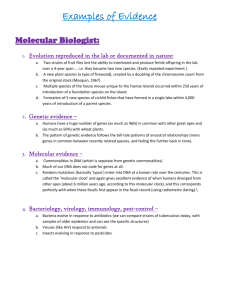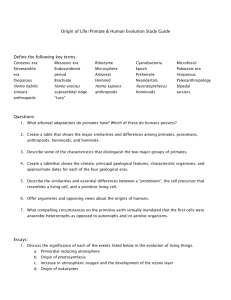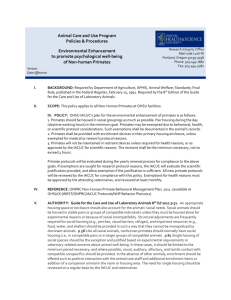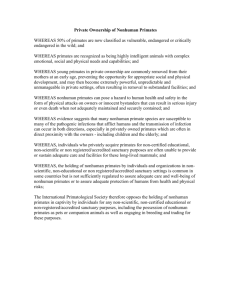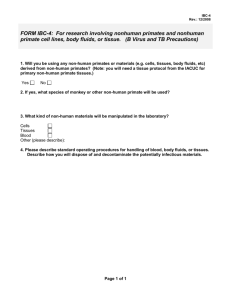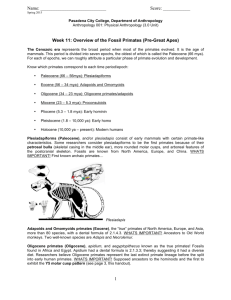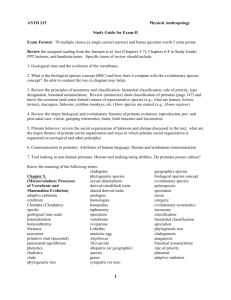Notes - Bruce Owen
advertisement
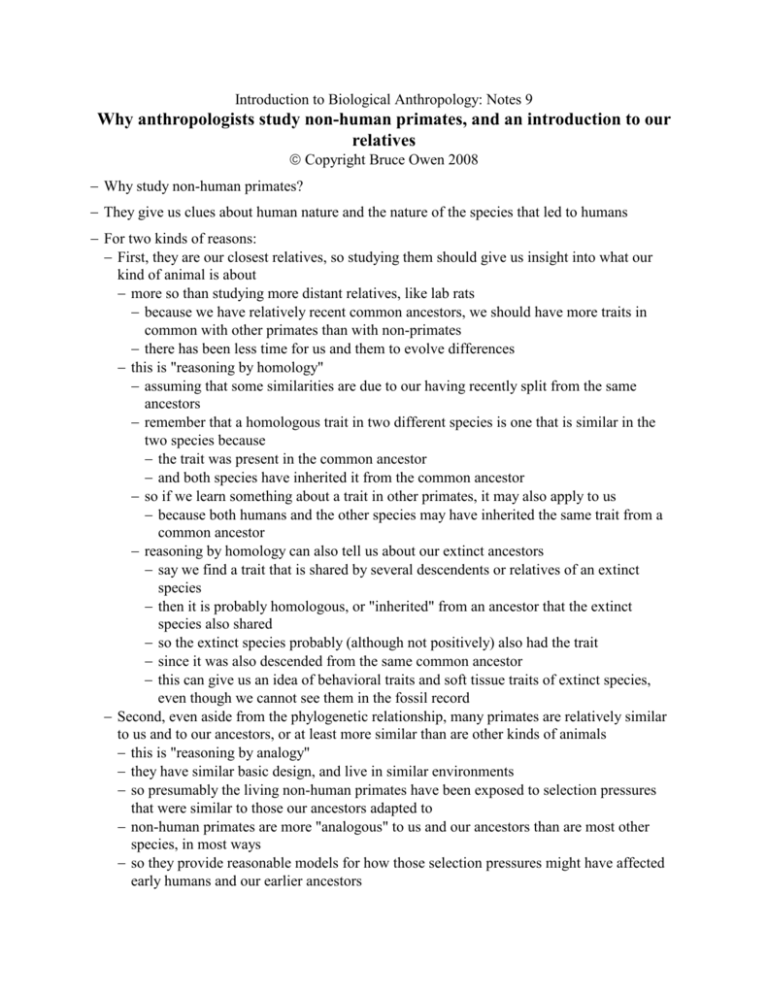
Introduction to Biological Anthropology: Notes 9 Why anthropologists study non-human primates, and an introduction to our relatives Copyright Bruce Owen 2008 − Why study non-human primates? − They give us clues about human nature and the nature of the species that led to humans − For two kinds of reasons: − First, they are our closest relatives, so studying them should give us insight into what our kind of animal is about − more so than studying more distant relatives, like lab rats − because we have relatively recent common ancestors, we should have more traits in common with other primates than with non-primates − there has been less time for us and them to evolve differences − this is "reasoning by homology" − assuming that some similarities are due to our having recently split from the same ancestors − remember that a homologous trait in two different species is one that is similar in the two species because − the trait was present in the common ancestor − and both species have inherited it from the common ancestor − so if we learn something about a trait in other primates, it may also apply to us − because both humans and the other species may have inherited the same trait from a common ancestor − reasoning by homology can also tell us about our extinct ancestors − say we find a trait that is shared by several descendents or relatives of an extinct species − then it is probably homologous, or "inherited" from an ancestor that the extinct species also shared − so the extinct species probably (although not positively) also had the trait − since it was also descended from the same common ancestor − this can give us an idea of behavioral traits and soft tissue traits of extinct species, even though we cannot see them in the fossil record − Second, even aside from the phylogenetic relationship, many primates are relatively similar to us and to our ancestors, or at least more similar than are other kinds of animals − this is "reasoning by analogy" − they have similar basic design, and live in similar environments − so presumably the living non-human primates have been exposed to selection pressures that were similar to those our ancestors adapted to − non-human primates are more "analogous" to us and our ancestors than are most other species, in most ways − so they provide reasonable models for how those selection pressures might have affected early humans and our earlier ancestors Intro to Biological Anthro S 2008 / Owen: Primates… p. 2 − that is, what works for other primates might have worked for us and our ancestors, too − What do non-human primates have to do with the evolutionary theory we have been looking at so far? − evolutionary theory will help us understand many features of non-human primate biology and behavior − evolutionary theory will help us to use information from the non-human primates correctly when we − use non-human primate analogies to understand human characteristics − try to reconstruct our own phylogeny − try to explain the sequence of changes that led from our early ancestors to modern humans − General characteristics of primates − Primates are one kind of mammal. As mammals, primates share many characteristics with each other and also with other mammals − lactation (mammary glands; nursing the young) − live birth ("viviparity") − as opposed to other animals that lay eggs − relatively long gestation period − hair − warm bloodedness ("homeothermy") − mammals regulate their own body temperature at a relatively constant temperature by controlling the production of body heat and cooling mechanisms − as opposed to modern reptiles, which have a variable body temperature depending on the environment around them − relatively large brains for a given body size − compared to non-mammals in general − this makes mammals, in general, more flexible in behavior than non-mammals such as reptiles − mammals generally have more capacity for learned behavior than non-mammals such as reptiles − four limbs with five digits each (shared with even more species, not just mammals) − etc. − since these characteristics are found in all mammals, by virtue of our all being descended from a common early mammal ancestral species, these are ancestral traits for primates. − Major characteristics that distinguish primates from other mammals − primates are quite a varied lot, but in general most share many "shared, derived, homologous traits" − that is, these are traits that are largely unique to primates − these traits are derived relative to all mammals − the common ancestor of all mammals did not have these traits − they appeared later, only in the particular lineage of mammals that led to the primates − these same traits are ancestral relative to primates − all primates have them because they are all descended from the same ancestral primate species Intro to Biological Anthro S 2008 / Owen: Primates… − − − − − − p. 3 − actually, some of these traits have been lost or are poorly developed in some primate lineages, but most primates have most of these traits increased emphasis on manual dexterity − prehensile (grasping) hands and feet, with opposable big toe and thumb − humans have lost the opposable big toe − flat nails rather than claws − finger pads with "fingerprints" on hands and feet locomotion is flexible and generalized, but usually hindlimb dominated − in contrast to obligatory quadrupeds like horses or dogs − or other specialized types of locomotion like kangaroos − tendency to upright body posture shift from smell to vision as most important sense − sense of smell often reduced in diurnal primates (those active during the day) − highly developed vision − large eyes − eyes in front of head rather than to the sides, with forward, overlapping fields of view for binocular vision − vision is not only binocular, but also stereoscopic − meaning that the images from both eyes are combined in the brain to allow estimation of distance using the stereo effect − in non-primate mammals, almost all the nerves from each eye go to just one side of the brain − the images are not combined − non-primate mammals estimate distances using other cues − in primates, many nerves from each eye go to both sides of the brain − the images are combined to allow distance perception using the stereo effect − diurnal primates (active during the day) all have color vision − nocturnal primates (active at night) do not increased emphasis on complex, flexible, learned behavior − brain larger (relative to body size) than other mammals − long gestation time, small litters or single births, long juvenile development period compared to other mammals − allows longer development of brain and longer period of learning − resulting in more complex behavior, especially social behavior most (but not all) primates live in social groups dental characteristics that reflect usually fairly flexible diet, not highly specialized for any one food − unspecialized molars − that is, designed to be reasonably good at grinding and tearing different kinds of foods, rather than to be very good at processing just one kind − compare to the specialized molars of grazers like cows − maximum 2 incisors, 1 canine, 3 premolars, 3 molars on each side of upper and lower jaws Intro to Biological Anthro S 2008 / Owen: Primates… p. 4 − written 2-1-3-3, called the "dental formula" − Dental formula: see explanation on pages 154-155 − some primates have lost one or more of these − humans have 2-1-2-3 − plus a bunch of other subtle characteristics − post-orbital bar − post-orbital plate (except in most prosimians) − shortened face − and others, some of which do not have very obvious functional significance − but probably are simply inherited from the common primate ancestor − primates that don't have one or the other of these traits have presumably lost it at some point since their particular line of descent split from the rest − that is, the absence of the trait in these primates is a derived trait for them − Where non-human primates live − Mostly tropics, especially dense forests, although some species live in more open forests or grasslands − Old World: Mostly Africa and southern Asia − New World: Central and tropical South America − Classification of primates − Handout; also available online from the class web page − This is part of the scientific (Linnaean) system of taxonomy we talked about earlier − that is, this chart shows how different species are lumped into genera, genera into subfamilies, etc. − this is the nested hierarchy used for naming these groups − Nevertheless, except for any errors (some details are still under debate), this naming system should also reflect the phylogeny (pattern of descent) of the primates − although the many branches that went extinct before the present are not shown − tarsiers are a problem; many people (including Boyd and Silk) think they really belong in the anthropoid suborder − I personally am convinced − but will stick with the traditional classification here − humans are also a problem − traditionally, we have classified ourselves in a separate family from other apes − because humans are so much more different from other apes than the apes are from each other − but it appears more correct in terms of our phylogeny to classify humans as just another genus in the same family as the other great apes − gorillas, chimps, orangutans, and us − the handout shows both options − This chart should help you understand why certain primates are similar to each other, and why others are more different − because you can see relatively how recently or long ago their lineages diverged Intro to Biological Anthro S 2008 / Owen: Primates… p. 5 − and what ancestral traits they share due to a common ancestor versus what traits differ because they are derived since the lineages split − for example, if you learn some features of hominoids, you know they apply to all the different hominoids shown (generally) − you can see the order of evolution of different traits − and guess at which ones were important in creating the pattern that led to us (or any other kind of primate) − What you need to know from this chart − you do not need to memorize the whole thing − this is not a major focus of the course − but the primates make a lot more sense if you consider how they are related − this chart may be helpful when you do the zoo project − for the purposes of Anthro 201, you should know: − the general structure down to the taxa (categories) marked on the chart with asterisks − the two reasonable placements of Homo sapiens − the taxa that are marked with asterisks − some features that distinguish each − their relationships (which groups are subdivisions of which) − one or more example groups or species in each − for example, know enough to describe very briefly what a prosimian, loris, tarsier, or lemur is − one approach is think of a typical species that illustrates each taxon − useful examples include ring-tailed lemurs or sifakas (either could represent lemurs) and the slow loris (representing lorises); we don't even discuss tarsiers by species here − know enough to explain what an anthropoid, Old World monkey, etc. is, maybe referring to a specific species to illustrate − useful examples include baboons (representing cercopithecines), langurs (representing colobines), and howler monkeys (representing New World Monkeys), although you could certainly pick others − know enough to briefly describe and differentiate the living hominoids: orangutan, gorilla, chimp, bonobo (pygmy chimp), gibbons and siamangs as a group, and humans − I suggest that you keep the primate taxonomy charts handy, and every time you come across a primate mentioned in the reading or your notes, try to locate it on the chart, noting what category of primates it represents, and what categories of primates it is more and less closely related to − You do not need to know − all the genera, species, and common names listed, just the ones that come up in the reading and lecture as interesting cases − all the subdivisions of the prosimians − Order: Primates − Suborders of primates: prosimians vs. anthropoids − Suborder: prosimians Intro to Biological Anthro S 2008 / Owen: Primates… p. 6 − our most distant primate relatives − the most varied category of primates − many nocturnal (active in the night), hence: − more developed sense of smell than other primates (wet, "naked" doglike nose) − large eyes − independently mobile ears − sensory whiskers − many arboreal, hence the four non-thumb digits act together, not independently − many have a "grooming claw" on the second toe only; nails on other digits − many have a "dental comb" comprised of the four lower incisor teeth and the lower canines, which are long, narrow, and close together, for use in grooming fur and gathering food − less complex behavior, less learning, relatively smaller, less developed brains than the anthropoids − most have the full three premolars − all prosimians except tarsiers have the post-orbital bar but lack the post-orbital plate; tarsiers have both, like anthropoids do − 3 infraorders: lemuriformes, lorisiformes, and tarsiiformes − lemuriformes (lemurs) − only on Madagascar (a huge island off southeastern Africa) − evolved there in isolation from competitors on mainland − including humans − lemurs were a case of adaptive radiation − they evolved in many different directions to fill many of the niches occupied by other animals on the mainland − there were lemurs the size of calves! − humans reached Madagascar around the time of Christ − and within a few centuries had completely exterminated all the larger lemurs − mostly the smaller, tree-dwelling, nocturnal ones survived − the SF zoo has an important project going to study, breed, and re-release Madagascar lemurs, and many prosimians that you can see − fantastic new lemur area - really fun, highly recommended − quadrupedal plus vertical clinging and leaping − lorisiformes (lorises) − African and Asian forests − small, nocturnal, arboreal − mostly eat fruit, gum, and insects − galagos: fast hoppers and runners ("bushbabies") − lorises: slow climbers and creepers − tarsiiformes (tarsiers) − high rain forests of Southeast Asia and Indonesia − small, nocturnal, arboreal − vertical clinging and leaping Intro to Biological Anthro S 2008 / Owen: Primates… p. 7 − eat insects and some small vertebrates − probably belong in the anthropoid suborder, rather than prosimians − Suborder: anthropoids − this is our branch: monkeys, apes, and humans − generally larger body size − mostly diurnal (active in the day) − retina with a fovea (central area of higher resolution vision) − absent in prosimians except the tarsiers − dry nose, reduced sense of smell − reduced sensory whiskers − independently controlled, dexterous digits − nails on all digits (no claws) − generally larger brain relative to body size − generally more complex behavior − post-orbital bar (like all primates) plus post-orbital plate − post-orbital plate is absent in prosimians except the tarsiers − see why the tarsiers seem to be more like anthropoids? − Two infraorders: Platyrrhines and Catarrhines − Infraorder: Platyrrhines − "flat nosed": round, forward-facing, widely separated nostrils − only in the New World, hence often called "New World monkeys" (NWMs) − three premolars on top and bottom − almost all diurnal − all mostly arboreal, living in forests − mostly quadrupedal, some able to swing by arms or tail − a few have prehensile tails, which are found only among the New World monkeys − specifically, only among one family of NWMs, the Cebids − one kind of Cebid is the capuchin monkey, which is notable for being one of just four primates that known to regularly make and use tools: − Capuchin monkey − use sticks as weapons, modify twigs and leaves to probe for insect larvae − Chimpanzees − Bonobos − Humans − consider where in the phylogeny of the anthropoids the tendency to use tools might have developed… − there is no one place on the phylogeny where tool-using could have appeared that would account for these four tool-using species − what might this suggest about the anthropoids in general? − Infraorder: Catarrhines − our branch − narrow, downward-facing nostrils − only in the Old World (except humans) Intro to Biological Anthro S 2008 / Owen: Primates… − − − − p. 8 two premolars on top and bottom, rather than three some have tails, but none are prehensile more variable adaptations than New World monkeys two superfamilies: Cercopithecoids (Old World monkeys) and Hominoids (apes and humans) − Superfamily: Cercopithecoids − Old World monkeys (OWMs) − highly variable group − arboreal and/or terrestrial − many different kinds of social organizations and mating strategies − often groups of numerous females and one or several males − Two subfamilies: Colobines and Cercopithecines − Subfamily: Colobines − most arboreal leaf-eaters − Africa and Asia − colobus monkeys: no thumbs (apparently an adaptation to moving through trees?) − langurs: sometimes called "leaf monkeys" − "Miss Waldron's Red Colobus": last seen in 1970's, declared extinct in September 2000 − Subfamily: Cercopithecines − many are semi-terrestrial − species are quite varied − Africa, plus macaques also live in Asia − typically live in large, multi-male, multi-female groups − baboons − macaques − vervet monkeys − Hominoids − our branch: apes and humans − generally the largest primates − no tails − relatively larger brains − Y-5 molars − basically forest dwellers, more or less arboreal − wide chest with shoulder blades (scapulae) on the back, rather than on the side as in quadrupeds − so the forelimbs can stick out sideways, rather than just moving forward and back − greater mobility of shoulders, elbows, wrists − these are presumably adaptations for complex climbing in trees, rather than just walking on top of branches − traditional classification has three families: hylobatids (lesser apes), pongids (great apes), and hominids (us) Intro to Biological Anthro S 2008 / Owen: Primates… p. 9 − we will use the more correct one in which hominids are included within the pongids (great apes) − Family: hylobatids − "lesser apes", generally smaller than the pongids − gibbons and siamangs − live in tropical forests of Asia − nearly full-time brachiators (overhand swingers through the trees) with very long arms − monogamous mating − little sexual dimorphism − males more involved in infant care than most other primates, especially the siamangs − highly territorial − Family: pongids − "great apes" − orangutans, gorillas, and chimps − should include humans, too − but many resist this, because humans are so different from other pongids − generally the largest primates − generally the largest brains relative to body size − orangutans − only on southeast Asian islands of Sumatra and Borneo − extreme sexual dimorphism in size, face, etc. − quadrumanual and arboreal when small, more terrestrial when grown to large size (especially males) − very solitary − fruit, leaf, and bark eater − gorillas − central African forests − small groups of one or two adult males, a few females, some young − eat leaves, stalks, bamboo − mostly terrestrial (although this may vary depending on their environment) − chimpanzees − and their close relatives, bonobos − called "pygmy chimps", even though they are not consistently much smaller − mostly eat plants, especially fruit, but sometimes insects and other animals − common chimps: large multi-male, multi-female groups centered on a stable group of related males who stay in their natal group − bonobos: female-centered groups − regularly use tools and modify objects to serve as tools − strip twigs to "fish" for termites − wad up leaves to sponge water out of cavities in tree trunks − crack nuts using a stone in one hand and a larger stone or root as an anvil Intro to Biological Anthro S 2008 / Owen: Primates… p. 10 − Family: hominids − us and our ancestors − hominids were traditionally placed in their own family − as if our lineage had long been separate from the pongids − this was basically vanity − the evidence suggests instead that we are just another kind of great ape − probably more closely related to chimps than gorillas are − much more detail later, but for now: − bipedal − reduced canines − huge brains for body size − Many non-human primates are in danger of extinction − capture for sale for pets or research (now partially controlled) − hunting for exotic meat or trophies for sale − hunted for "bush meat": in some areas, wild animals are not owned by anyone nor effectively protected, so they are a source of cheap meat or minor income for desperate people who can't afford beef, pork, or other preferred species − humans are driving our only close relatives to extinction for the equivalent of cheap horsemeat − but ultimately, the biggest reason is the reduction of habitat by logging, farming, ranching − there are fewer and fewer "wild" places where they can live − We will come back to many of these primates as examples or case studies
